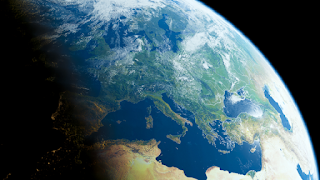Planet Earth, which orbits the sun at 67,000 miles per hour, attracts many strange creatures, extreme climates, and other interesting conditions.
Here are some of the most important facts about Earth:
1. The Earth is billions of years old
Researchers calculate the age of our planet by dating the oldest rocks on the planet and meteorites discovered on its surface.
They estimate the age of the Earth at about 4.54 billion years, according to the US National Center for Science Education.
2. The earth is recycled
The igneous rock cycle transforms igneous rocks into sedimentary, then metamorphic, and then repeats the process again.
Magma emerges from deep within the Earth and hardens to form rocks (the igneous part). Tectonic processes raise these rocks to the surface, where erosion breaks them down. The detritus is deposited and buried, turning into sedimentary rocks such as sandstone as a result of pressure. If sedimentary rocks are buried deeper, they "mature" and turn into metamorphic rocks under a lot of pressure and heat.
If metamorphic rocks get stuck in a subduction zone, where one piece of crust pushes under another, they may turn back into magma.
3. Chile witnessed the largest earthquake on Earth
The largest earthquake in the world had a magnitude of 9.5, and occurred in Bío Bío, Chile on May 22, 1960, according to the United States Geological Survey (USGS).
4. The hottest spot in Libya
The hottest spot on Earth is in Al-Aziziya, Libya, where temperature records from weather stations reveal that it reached 57.8 degrees Celsius on September 13, 1922, according to NASA's Earth Observatory.
There are likely to be hotter locations outside the network of weather stations.
5. The coldest place on Earth is in Antarctica
Winter temperatures can drop as low as 73 degrees Celsius.
6. Giant stalagmites
The world's largest confirmed stalagmite can be found in Cuba at Cuevo San Martin Infierno, according to Acta Carsologica magazine.
7. There is unequal attraction
Because the Earth is imperfect, its mass is unevenly distributed. An uneven mass means a slightly uneven gravity.
One mysterious gravity anomaly exists in Hudson Bay in Canada, which has lower gravity than other areas, and a 2007 study found that now-melting glaciers are to blame.
8. Swinging pole
Over the past 20 million years, our planet has settled into a pattern of polar reversal approximately every 200,000 to 300,000 years, according to the journal Nature. However, as of 2012, more than twice that long has passed since the last reversal.
These reversals occur over hundreds or thousands of years. During this long period, the magnetic poles begin to move away from the region around the rotation poles (the axis around which our planet rotates), and eventually end up switching, according to astronomers at Cornell University.
9. Tied for tallest mountain
The title of tallest mountain on Earth goes to either Mount Everest or Mauna Kea.
Mount Everest is known to be the highest above sea level of any other mountain, with a height of approximately 8,848 metres, according to the Indian Journal for the History of Science.
However, when measured from its true base to the summit, Mauna Kea gets the title, as it is about 17,170 meters tall, according to the US Geological Survey.
10. The Earth attracted two moons in the past!
The tiny second moon may have orbited Earth before catastrophically colliding with the other moon, according to Space.com.
Scientists said that this giant clash may explain the reason for the great difference between the two sides of the current moon.
11. Coral reefs are the largest living structures
Coral reefs support the most species per unit area of any ecosystem on Earth, rivaling rainforests. They are the largest living structures on Earth, and can be monitored from space, according to NOAA.
12. Mariana Trench “the deepest point” on Earth
According to NOAA, the deepest point on the ocean floor is 11,033 meters below sea level in the Mariana Trench. It is located in the western Pacific Ocean, east of the Northern Mariana Islands.
13. The ground was purple
Life on early Earth may have been just as purple as it is green today, according to Shail Das Sarma, a microbial geneticist at the University of Maryland.
He said that ancient microbes may have used a molecule other than chlorophyll to harness sunlight, which is the molecule that gave living organisms a violet color.
14. The Earth is covered in cosmic dust
About 100 tons of interplanetary material (mostly in the form of dust) drift to Earth's surface every day. The smallest particles are released by comets when their ice evaporates near the Sun.
15. There was once a supercontinent
It is believed that Earth's continents collided to become supercontinents, and separated again several times during Earth's history. The last supercontinent was called Pangea, which began to break up about 200 million years ago.
Eventually, the land masses that comprised Pangea moved to form the current configuration of the continents.
16. The Pacific Ocean is the largest basin on our planet
The Pacific Ocean is by far the largest basin on Earth, covering an area of about 163 million square kilometers, according to NOAA.
17. Greenland has the largest open space
It has the lowest population density ever on Earth. As of 2016, 55,847 people lived in an area of 2,180,000 square km, according to ScienceNordic.
Most settlements in Greenland are clustered on the coast, so this low population density is somewhat misleading.
18. Atacama “the driest place” on Earth
The driest non-Arctic desert on Earth is located between Chile and Peru, according to Antonie van Leeuwenhoek. In the middle of this desert there are places where rain has never been recorded before.
Tags:
biggest mystery
earth
earth future
mutual interest
mysterious structures
mystery of mysterious
science
scientific facts
topnews




The Earth is an unique planet.
ReplyDeleteThanks for the creator
ReplyDeleteGood
ReplyDelete